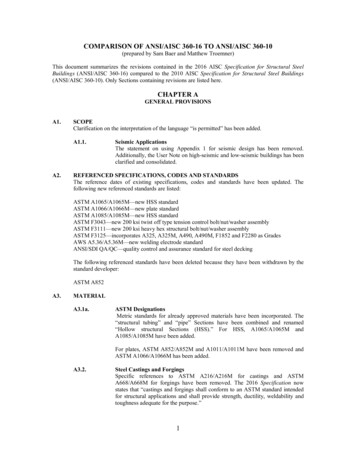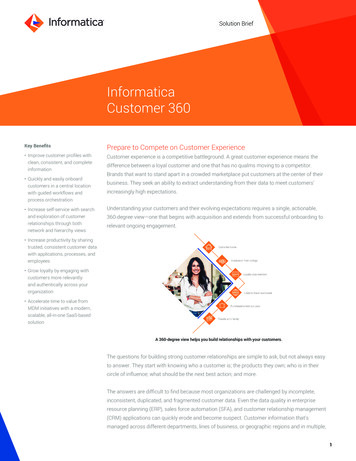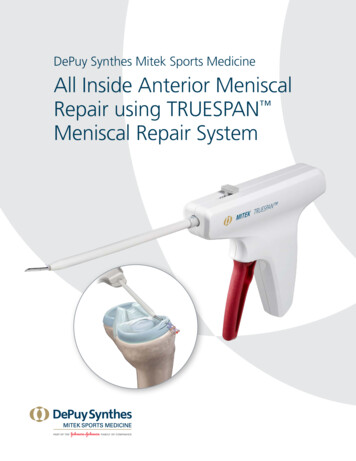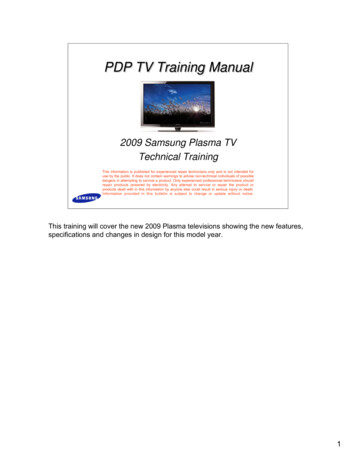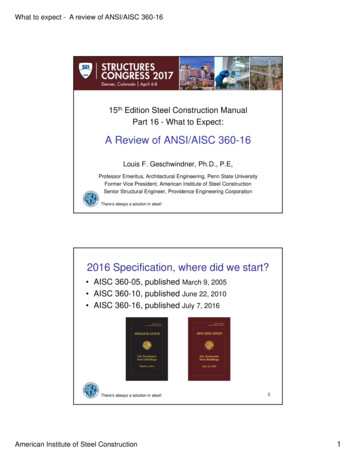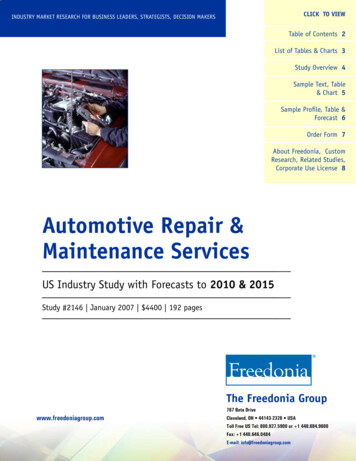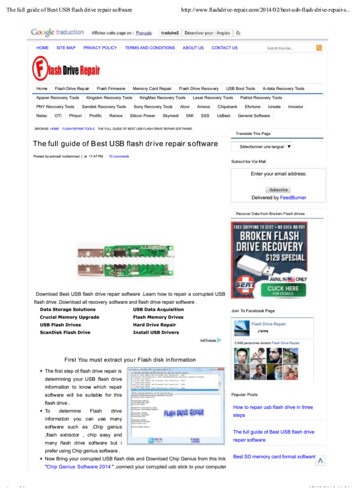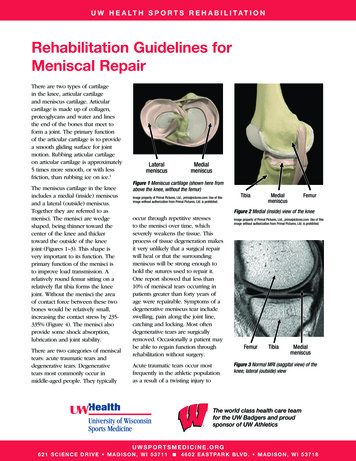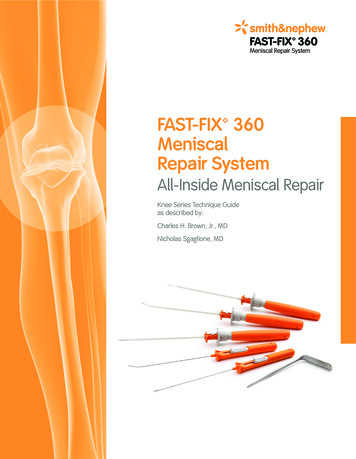
Transcription
FAST-FIX 360Meniscal Repair SystemFAST-FIX 360MeniscalRepair SystemAll-Inside Meniscal RepairKnee Series Technique Guideas described by:Charles H. Brown, Jr., MDNicholas Sgaglione, MD
All-Inside Meniscal Repair with theFAST-FIX 360 Meniscal Repair SystemIntroductionThe meniscus contributes to optimal knee joint function because of its critical role in loadtransmission, shock absorption, joint stability, lubrication, articular cartilage nutrition,and neuromuscular proprioception. Clinical studies have demonstrated that even partialmeniscectomy can lead to early joint chondrosis and arthrosis 1. As a result, repair of peripheraland red/white meniscal tears is now the standard of care.Due to the ability to predictably place vertical or horizontal mattress sutures on the femoral ortibial surfaces of the meniscus, the inside-out repair technique is considered by many surgeonsto be the “gold standard” for meniscal repair. However, the inside-out technique requires aposterior incision and dissection to avoid neurovascular complications, thereby adding morbidityand operative time to the procedure. The technique also requires a trained assistant to retrieveand tie the repair sutures.As described by:Charles H. Brown, Jr., MDMedical DirectorAbu Dhabi Knee & Sports Medicine CentreAbu Dhabi, United Arab EmiratesNicholas Sgaglione, MDAssociate Chairman and Program DirectorDepartment of Orthopaedic SurgeryNorth Shore-Long Island Jewish Medical CenterNew Hyde Park, New YorkThe outside-in repair technique was introduced in an attempt to eliminate the need for aposterior incision and dissection. However, the outside-in technique offers limited access totears in the posterior third of the meniscus and limits the surgeon’s ability to perform a verticalmattress suture and place sutures on the tibial surface of the meniscus.The all-inside arthroscopic suture-based technique has addressed many of the limitations ofthe inside-out and outside-in techniques. The all-inside suture-based technique has gainedpopularity because of the following advantages: The repair can be safely performed without a posterior incision. The technique allows easy access to tears in the posterior and middle thirds of the meniscus. The repair can be performed without a trained assistant. The technique allows vertical or horizontal mattress sutures to be inserted on the femoral ortibial surface of the meniscus.These advantages allow for minimally invasive meniscal repair, resulting in less postoperativepain and morbidity for patients 2.FAST-FIX 360 Meniscal Repair System All-Inside Meniscal Repair3
OverviewThe FAST-FIX 360 Meniscal Repair System provides a strong, reproducible, and time-saving technique for meniscalrepair. Biomechanical studies have demonstrated that a vertical mattress suture performed using the FAST-FIX 360Meniscal Repair System has biomechanical properties equal to that of a vertical mattress suture performed using theopen and inside-out repair techniques. This result can be achieved without the previously mentioned disadvantagesand limitations of the inside-out and outside-in repair techniques, and without the need for intra-articular knot tying.The system gives the surgeon the versatility of placing horizontal or vertical mattress sutures on the femoral or tibialsurfaces of the meniscus, potentially minimizing risk to the posterior neurovascular structures.Building on the proven clinical success of the earlier FAST-FIX and ULTRA FAST-FIX Meniscal Repair Systems’techniques, the all new FAST-FIX 360 Meniscal Repair System offers the following advantages: Easier and faster implant deployment with added safety features More controlled implant delivery Smaller insertion points, minimizing disruption to the meniscus Less needle advancement needed for implant delivery A built-in depth penetration limiter Stiffer needle shaft for enhanced delivery control Ability to reposition the needle for optimal suture placementAs a result, the FAST-FIX 360 Meniscal Repair System (Figure 1) helps optimize the chances of a successfulmeniscal repair.As with all arthroscopic procedures, adequate joint distention and visualization of the meniscus tear are essentialfor success. To minimize the potential for damage to neurovascular structures, it is strongly recommended that thesurgeon use the built-in, adjustable depth penetration limiter to control the depth of penetration of the deliveryneedle. The tear is precisely assessed and the point of needle insertion from the peripheral rim is measured with ameniscal depth probe. This measurement is used to set the built-in adjustable depth penetration limiter.Unlike the earlier FAST-FIX Meniscal Repair System, implants in the new FAST-FIX 360 Meniscal Repair Systemare pushed out of the delivery needle rather than being stripped away from the needle. This new delivery methodminimizes the depth of needle penetration needed to successfully deploy the implants, thereby decreasing therisk of injury to nearby neurovascular structures. The FAST-FIX 360 Meniscal Repair System also employs a newergonomically shaped 360 deployment slider which makes a “clicking” sound upon deployment of the implants.These new features provide a more controlled method to ensure proper implant deployment.Auditory confirmationAdjustable depth limiterNeedle tip availablein curved, reversecurved, and straightErgonomic handleEnhanced suturemanagement360 active deployment sliderLaser-markedneedle tipStiffer, low-profile needle shaftSmaller implants andULTRABRAID 2-0 SutureFigure 1. The FAST-FIX 360 Meniscal Repair System.4FAST-FIX 360 Meniscal Repair System All-Inside Meniscal Repair
SetupEach FAST-FIX 360 Meniscal Repair System contains two 5 mm polymer integrated bio-inert anchors(PEEK-OPTIMA from Invibio ) with a pretied, self-sliding knot comprised of 2-0, non-absorbable, UHMWpolyethelene ULTRABRAID Suture. The entire system is packaged in an easy-to-insert integrated delivery needle.The delivery needles are available in curved, straight, and reverse curved designs (Figure 2). The curved andreverse curved designs allow the surgeon to rotate the needle tip away from the neurovascular structures whenpenetrating the meniscus, further reducing the risk of neurovascular injury. The curved delivery needle is optimallyshaped to allow vertical mattress sutures to be inserted on either the femoral or tibial surfaces of the meniscus.The reverse curved delivery needle is most useful for repairing tears on the tibial surface and more anterior locatedtears. The anchors are placed into the meniscus sequentially and are seated safely outside the capsule. The sutureis then tensioned in a simple manner without the need for arthroscopic knot tying.The built-in, adjustable depth penetration limiter is adjustable from 10 mm to 18 mm from the tip of the needle. Thedevice comes with the depth penetration limiter preset at 18 mm. Patients with small knees, peripheral tears in thered-red zone, tears around the popliteus hiatus, and tears in the middle third of the medial meniscus may requirea delivery depth less than the preset depth of 18 mm. Use of the meniscal depth probe in conjunction with theadjustable depth penetration limiter (white plastic sheath) allows controlled delivery of the implants.Figure 2. Delivery needle designs.Procedure Setup and Portal PlacementThe operating room setup includes a lateral thigh post or leg holder to allow application of valgus stress to the kneeto open the medial or lateral compartments for easier access to the tear. Use a surgical skin marker to outline thefollowing surface landmarks: the patella, the medial and lateral borders of the patellar tendon, and the medial andlateral joint lines. Create the anterolateral portal at the level of the inferior pole of the patella as close as possible tothe lateral border of the patellar tendon. Perform diagnostic arthroscopy, identify the meniscal tear, and assess itssuitability for repair. Create the anteromedial portal under direct arthroscopic visualization. Insert an 18 gauge needlethrough the skin above the medial joint line. Adjust the needle position to allow optimal insertion of the FAST-FIX 360delivery needle. Adjust the external starting position for the needle so that the needle can be placed perpendicularto the tear. Create the anteromedial portal in routine fashion using a #11 blade. It is important to dilate the portal withthe arthroscopic blunt obturator to allow for easier passage of the delivery needle into the joint.Repair lateral meniscal tears by viewing the tear through the anterolateral portal and using the anteromedial portalfor the delivery needle. For a medial meniscal tear, use the meniscal depth probe to determine if the sutures shouldbe inserted through the anteromedial portal or if it is necessary to switch the scope to the anteromedial portal andinsert the sutures through the anterolateral portal. In general, medial meniscal tears in the middle third zone are bestrepaired by inserting the sutures through the anterolateral portal. This approach allows the sutures to be insertedperpendicular to the tear. Because the tibial spines can interfere with optimal suture placement when the suturesare inserted through the anterolateral portal, in some cases it may be necessary to insert the sutures through theanteromedial portal.FAST-FIX 360 Meniscal Repair System All-Inside Meniscal Repair5
ProcedureFigure 3. Establishdepth limit usingthe adjustabledepth limiter anddepth probe.Figure 4. Uselaser marks as areference.Meniscal tear site preparation is essential for biologicalhealing of the tear. Meniscal rasps and/or arthroscopicshavers are used to abrade and excoriate both sidesof the tear and the perimeniscal synovium. Once theoptimal portal placement is determined and the meniscaltear site is prepared, perform the repair as follows:1. Use the meniscal depth probe to determine thedesired depth limit. Place the tip of the probe at themeniscosynovial junction and measure the widthof the meniscus at the desired entry point for thedelivery needle. In the average size knee a depthof 14 mm is usually adequate. Adjust the depthpenetration limiter to the desired length by pressingthe depth limiter button (Figure 3). This length canbe adjusted outside or inside of the joint. The lasermarks on the tip of the needle can also be used as areference (Figure 4).2. Insert the FAST-FIX 360 delivery needle into the jointthrough the appropriate arthroscopic portal. Insertionis facilitated through the use of the slotted cannula(sold separately) (Figure 5).Figure 6.Introduce thedelivery needleinto the jointwith the tipdown againstthe slottedcannula.Figure 5. Use a slottedcannula to ease insertion.The slotted cannula eases passage through thefat pad, and the cannula can also be used to helpposition the tip of the delivery needle at the desiredlocation on the meniscus. Introduce the deliveryneedle through the slotted cannula into the joint,ensuring that the tip of the needle is pointing down(Figure 6). Once the needle is inside the joint, theslotted cannula may be removed if desired.Pearl: Hold the delivery needle at the handleand push the slider with the thumb to deploy theimplants. Do not advance the deployment slider whileintroducing the delivery needle into the joint or theimplant will deploy prematurely.6FAST-FIX 360 Meniscal Repair System All-Inside Meniscal Repair
Figure 7. Insert the delivery needle into the meniscus throughthe capsule.Figure 8. Keep the delivery needle in position during deploymentof the implants.Figure 9. Push the deployment slider all the way forward todeploy T1.Figure 10. Withdraw the delivery needle from the meniscus slowlyfor better suture management.Vertical Mattress Suture Repair3. For a vertical mattress suture repair, place the first implant (T1) on thecapsular side of the tear. Insert the FAST-FIX 360 delivery needle intothe capsule or into any remaining meniscal tissue on the capsular sideof the tear (Figure 7). Use the slotted cannula to stabilize the meniscus,enhance visualization, and minimize skiving of the delivery needle toensure more accurate placement of the implants. Position the tip of theslotted cannula at the desired entry point and rotate the cannula awayfrom the direction of the neurovascular structures. Rotating the cannulaallows better visualization of the delivery needle tip and directs theneedle away from the neurovascular structures. Keeping the deliveryneedle in position, push the deployment slider all the way forwardto deploy T1 (Figures 8 and 9). Proper deployment of the implant isaccompanied by a “clicking” sound. For better suture management andto prevent pulling out the second implant (T2), release the deploymentslider and slowly withdraw the needle out of the meniscus, keeping theneedle inside the slotted cannula (if desired) and within arthroscopic view(Figure 10).Figure 11. Make sure the trigger is flush to the handleprior to deploying T2.Pearl: Release the slider right after deployment of T1 to allow the“spring back” of the slider to its original position flush with the handle topick up the T2 implant (Figure 11). Do not slowly release or hold the slider.If the slider does not spring back, the user may manually return the sliderto its original position.FAST-FIX 360 Meniscal Repair System All-Inside Meniscal Repair7
Figure 12. Advancethe delivery needleto the presetneedle depth limit.Figure 13. Push thedeployment sliderall the way forwardto deploy T2.Position the slotted cannula at the desired entrypoint on the inner meniscal fragment (if desired).The entry point for the second (T2) implant shouldbe at least 5 mm from the tear site. Advance thedelivery needle until the depth penetration limitercontacts the surface of the meniscus (Figure 12).Keeping the delivery needle in position, push thedeployment slider all the way forward to deploy T2(Figure 13). As with T1, proper deployment of T2 isaccompanied by a “clicking” sound. Slowly withdrawthe delivery needle from the joint after deploymentof T2 (Figure 14).Pearl: Do not push the deployment slider until theneedle is fully penetrated through the meniscus tothe preset depth limit or T2 will deploy prematurely.Horizontal Mattress Suture RepairFigure 14. Withdrawthe needle from thejoint.Figure 15. Pull thefree end of thesuture.Figure 16. Applytension to thesuture to cinch theknot down.84. For a horizontal mattress suture repair, place thefirst implant (T1) at the posterior location. Place thedelivery needle perpendicular to the tear and aminimum of 5 mm from the tear site on the innermeniscal fragment. Advance the delivery needle untilthe depth penetration limiter contacts the surfaceof the meniscus. Keeping the delivery needle inposition, push the deployment slider all the wayforward to deploy T1. Proper deployment of the implantis accompanied by a “clicking” sound. Release thedeployment slider and slowly withdraw the deliveryneedle out of the meniscus, keeping the needlewithin arthroscopic view. Position the delivery needlemore anteriorly along the meniscal tear site for theinsertion of the second limb of the horizontal mattresssuture. In general, maintain a minimum width of 8 mmbetween the two insertion points. Advance the deliveryneedle until the depth penetration limiter contacts thesurface of the meniscus. Keeping the delivery needlein position, push the deployment slider all the wayforward to deploy T2. As with T1, proper deploymentof T2 is accompanied by a “clicking” sound. Slowlywithdraw the delivery needle from the joint afterdeployment of T2.Pearl: Do not push the deployment slider until theneedle is fully penetrated through the meniscus tothe preset depth limit or T2 will deploy prematurely.5. Remove the delivery needle from the knee, pullingthe free end of the suture out of the joint. The freeend of the suture is pulled to advance the sliding knotand reduce the meniscal tear (Figure 15). It is normalto encounter firm resistance as the knot is snuggeddown. It is important to pull the free end of the suturedirectly perpendicular to the tear site. Wrap the suturearound several fingers and use the tibia as a fulcrumto provide a controlled method of tightening the knot.Slowly and steadily apply tension to the suture. Inmost cases, this steady pulling of the suture will cinchthe knot down (Figure 16).Pearl: If too much resistance is encountered whileadvancing the knot, use the Smith & NephewStraight or Curved Knot Pusher/Suture Cutter (soldseparately) to help facilitate removing suture laxity.FAST-FIX 360 Meniscal Repair System All-Inside Meniscal Repair
Figure 17. Slide the knot pusher/suture cutter to the knot.Figure 18. Push the knot pusher/suture cutter tip against the knotto recess the knot.Figure 19. Push the trigger to cut the suture.Figure 20. Completed vertical mattress stitch.6. To further tighten the knot and further compress the tear site, thread the free end of thesuture through the knot pusher/suture cutter. Both curved and straight knot pushers/suturecutters are available. Use a suture funnel to facilitate threading of the suture.7. While holding the suture taut, gently slide the knot pusher/suture cutter to the knot(Figure 17). The knot pusher should engage the suture in a direct line perpendicular tothe repair. A manual suture “pull”/“push” maneuver is suggested, and the knot should betightened until the desired amount of compression is generated at the tear site.8. Position the tip of the knot pusher/suture cutter against the knot to ensure a 2–3 mm suturetail when the suture is cut. Continuing to hold the suture taut, push the knot pusher/suturecutter tip against the knot. In some cases it is possible to recess the knot into the surface ofthe meniscus, leaving the tail of the suture flush with the surface of the meniscus (Figure 18).Cut the suture by pushing the trigger forward (Figures 19 and 20). Because of the highstrength of the suture, using a small arthroscopic basket punch or scissors to cut the sutureoften results in the tail of the suture being frayed.9. Place sutures on the tibial side of the tear as well as the femoral side of the tear to reducepuckering of the meniscus. The reverse curved delivery needle is especially useful for placingsutures on the tibial side of the tear.FAST-FIX 360 Meniscal Repair System All-Inside Meniscal Repair9
Postoperative CareThe FAST-FIX 360 Meniscal Repair System utilizes a high strength non-absorbable suture andallows the repair to be performed with a vertical mattress suture, which has been shown to bethe strongest meniscal repair technique. As a result, the standard rehabilitation protocol usedwith inside-out repairs can be utilized.Additional InstructionPrior to performing this technique, consult the Instruction for Use documentation providedwith individual components – including indications, contraindications, warnings, cautions,and instructions.Pearls Prepare meniscal tear site properly. Choose the portal which most easily allows the delivery needle to be insertedperpendicular to the tear site. Set the depth penetration limiter. Use curved or reverse curved delivery needles. Vertical mattress suture: T1 inserted into the capsular side of the tear; T2 insertedon the meniscal side of the tear. Hold the device at the handle and push the slider with the thumb to deploy T1 and T2. Keep the device in position during deployment of T1 and T2. Release slider after deployment of T1 to allow “spring back” of the slider to pick up T2. For better suture management and to prevent pulling out T2, release the deployment sliderand slowly withdraw the needle out of the meniscus. Thread suture onto the knot pusher/suture cutter with the suture funnel. If the knot does not cinch smoothly, it usually requires a steady and more forceful pull, which isfacilitated by wrapping the suture around several fingers, like a pulley, and applying tension. Cinch the knot to obtain the desired degree of compression at the tear site. Avoid over-cinching the knot, which can result in puckering of the meniscus or the suturecutting through the meniscus and weakening the repair. Alternate divergent femoral side and tibial (tensile) side suture placement optimizes thestrength of the repair and helps achieve an anatomic repair. Consider the reverse curved delivery needle for placing sutures on the tibial surfaceof the meniscus. Place the FAST-FIX 360 delivery needle either through the inferior (tibial) or superior (femoral)surface of the meniscus for optimal strength. For the easiest knot sliding and avoidance of the neurovascular bundles, insert the needleperpendicular to the tear using a contralateral approach. Use portals placed adjacent to thepatella tendon to facilitate this procedure. The pretied, self-sliding knot included in the FAST-FIX 360 Meniscal Repair System slidesfrom (T1) to (T2). Therefore, placing T1 further away than T2 facilitates sliding of the knot. Maintaining the needle insertion tip within the arthroscopic view at all times avoids potentialsuture tangling.10FAST-FIX 360 Meniscal Repair System All-Inside Meniscal Repair
Ordering InformationTo order the instruments used in this technique, call 1 800 343 5717 in the U.S.or contact your authorized Smith & Nephew representative.REFDescription72202467FAST-FIX 360 Straight Needle72202468FAST-FIX 360 Curved Needle72202469FAST-FIX 360 Reverse Curved Needle72202674Straight knot pusher/suture cutter and slotted cannula set, single use72202675Curved knot pusher/suture cutter and slotted cannula set, single useAccessories:015186Meniscal depth probe, reusable01454945 Diamond rasp, reusable01455090 Diamond rasp, reusable7210977Slotted cannula, reusable7210450Suture funnel, sterile, box of 107209950Suture threaders, sterile, box of 10References1. Ak. Joy Singh, Nilachandra L, Y.Nandabir Singh, Brogen Ak. Rehabilitation FollowingArthroscopic Partial Meniscectomy - A Neglected Issue. IJPMR 15, April 2004; 1-6.2. Nicholas A. Sgaglione, Meniscus Repair: Update on New Techniques: Techniques inKnee Surgery 1(2): 113-127, December 2002.CAUTION: U.S. Federal law restricts these devices to sale by or on the order of a physician.Courtesy of Smith & Nephew, Inc., Endoscopy Division Trademarks of Smith & Nephew, registered U.S. Patent & Trademark Office.All trademarks acknowledged.EndoscopySmith & Nephew, Inc.Andover, MA 01810USAwww.smith-nephew.com 1 978 749 1000 1 978 749 1108 Fax 1 800 343 5717 U.S. Customer Service 2010 Smith & Nephew, Inc.All rights reserved.04/2010 10600542 Rev. A
The all-inside arthroscopic suture-based technique has addressed many of the limitations of the inside-out and outside-in techniques. The all-inside suture-based technique has gained popularity because of the following advantages: The rep
